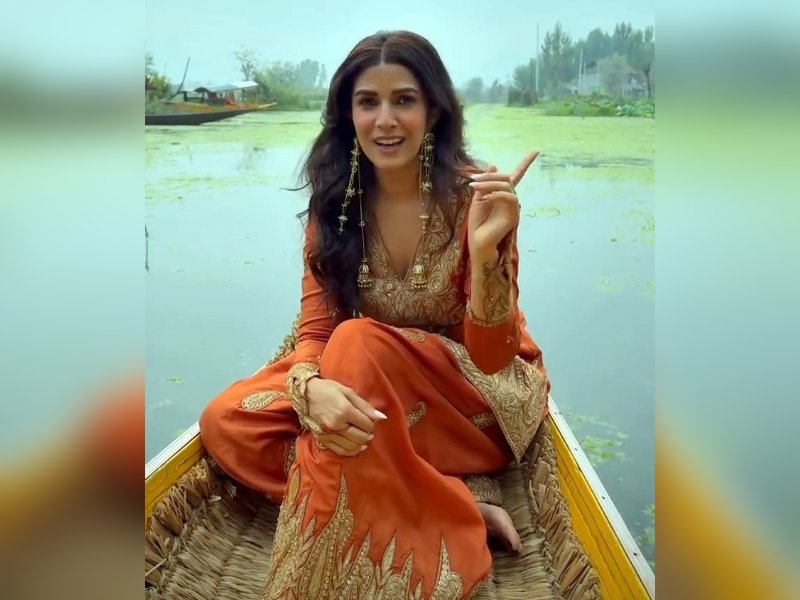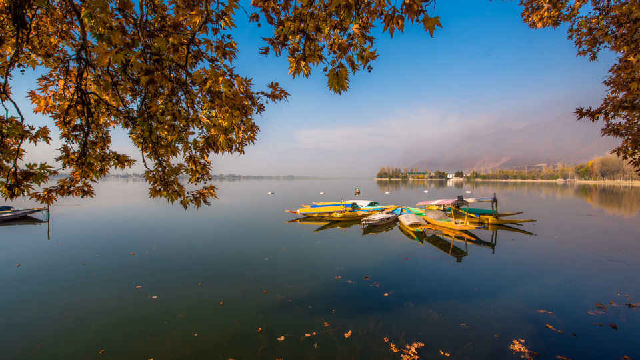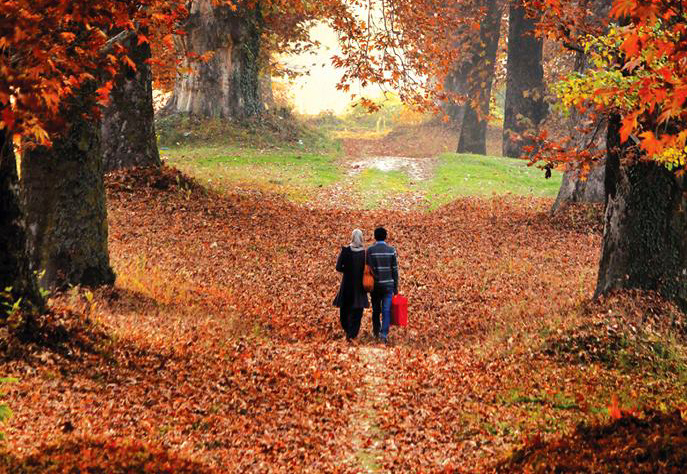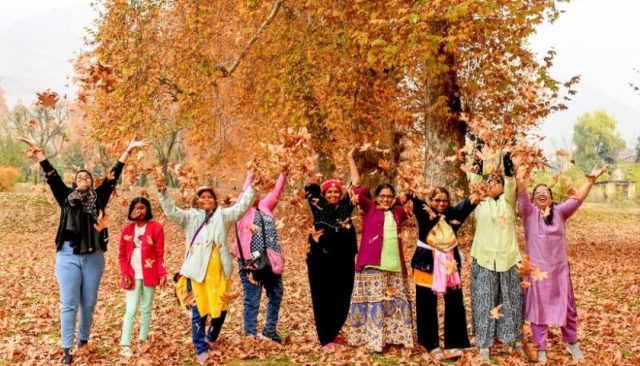Like Nimrat Kaur, Experience a Shikara Boat Ride on Dal Lake, Kashmir 2025
By: Javid Amin | 03 October 2025
Bollywood Glam Meets Kashmiri Charm
The viral video of Bollywood actress Nimrat Kaur drifting across Dal Lake in a traditional shikara boat has rekindled fascination with Kashmir’s timeless waterways. In the clip, she sits composed in a rust-orange suit, the soft hum of oars, the lake’s mirrored surface, and the snow-dusted mountains in the distance. She quotes Amir Khusro, “If there is paradise on earth, it is this, it is this, it is this,” awakening a certain nostalgic longing in viewers.
But beyond the allure of celebrity lies something more enduring: a way to experience Kashmir that blends calm, culture, and connection. In this guide, we’ll take you beneath the surface—through the history, the practicalities, the hidden charm—and show how you can enjoy your very own shikara ride, just like Nimrat.
The Star’s Moment of Stillness
01. Nimrat’s Kashmir Voyage in Context
Nimrat Kaur’s presence on Dal Lake was no fleeting snapshot; it was a deliberate ode to stillness. The video she shared on Instagram shows her in contemplative quiet, eyes tracing the ripples she makes, as she narrates:
“Every time you come here, you are reminded of your childhood memories… like the child in you has been awakened.” www.ndtv.com
She mentions her first visit to Srinagar with family, and how returning feels like revisiting the child within her—a sentiment echoed by many travelers who pass through Kashmir’s valley.
The backdrop is classic Kashmir: floating gardens, ornate houseboats, distant hills. This quiet, visual poetry captured public imagination and became instant travel inspiration.
02. Why It Resonated
There are a few layers to why her post struck a chord:
-
Contrast to the usual glamour: Many celebrity travel posts focus on luxury villas or curated escapes. Nimrat chose a humble, timeless mode of travel.
-
Emotional memory: Her mention of childhood and returning to roots taps into a deep emotional chord—travel isn’t just seeing new places; it’s reconnecting with parts of yourself.
-
Visual symbolism: The shikara—and water itself—evoke serenity, reflection, flow. It mirrors an inner journey.
By turning attention to something so simple, she reminds us: sometimes the quietest experiences leave the strongest impressions.
Also Read | Why Gulmarg Reigns as India’s Best Winter Destination in 2025–26
The Shikara Experience: More Than Just a Ride
When we speak of a shikara ride in Kashmir, it’s not merely a boat trip. It’s an immersion in culture, history, nature, and local life. Let’s dive deeper into what you see, feel, and absorb on that gentle glide across water.
01. What Is a Shikara?
The shikara is a wooden boat unique to the lakes of Kashmir—especially Dal Lake and its adjoining waters. It is a cultural icon, akin to gondolas in Venice.
Key features:
-
Design & size: Typically seats six people. The boatman paddles from the rear.
-
Purpose: Not just for tourists—shikaras are used for transport, fishing, transporting aquatic vegetation, or moving between houseboats and gardens.
-
Canopies & cushions: Many are fitted with tarpaulin covers, cushioned seating, and backrests for comfort.
-
Floating attributes: Some shikaras roam the floating gardens, delivering goods—flowers, vegetables, saffron—to households and markets.
When you step into a shikara, you’re stepping into living tradition—a vessel that has ferried locals and visitors for centuries.
02. What You See—Panoramas & Moments
A shikara ride is a series of slow, unfolding views. Here are some visual treasures you’ll encounter:
-
Zabarwan Range: The slopes that cradle Dal Lake form a dramatic skyline—shades shifting with light, mist, and clouds.
-
Mughal Gardens: Nishat Bagh, Shalimar Bagh, Chashme Shahi—they border portions of the lake and are accessible by shikara.
-
Floating gardens (“Raad”): Tangled mats of lotus, water lilies, reeds, forming fragile islands on the lake.
-
Houseboats & ghats: Elegant wooden houseboats moored at the edges, their verandas reaching towards the water. Ghats—boat-launch points—lined with tourists and locals.
-
Reflections & light: The lake mirrors the sky, the trees, the structures—creating painterly scenes.
-
Birdlife & wildlife: Kingfishers, herons, other lake birds perched on willows or floating mats.
These are not postcard snapshots; they are unfolding, living frames.
03. Cultural Threads in the Ride
Your shikara ride is also a thread in the tapestry of Kashmiri life:
-
Floating markets: Vendors in smaller shikaras row close, selling flowers, saffron, fruits. You might pick something fresh right off the boat.
-
Interaction with boatmen: Many boatmen are local families passed down generations—stories, songs, local lore often spill during the ride.
-
Connection to houseboats: Many houseboats include shikara rides for guests as part of their stay package.
-
Photo-op in local dress: Some boats offer traditional Kashmiri attire for a few minutes so you can personalise your memory.
-
Serenity & reflection: The unhurried pace invites quiet thought, splashes, soft breezes, and meditative sits.
This is not thrill tourism; this is an invitation to slow your pulse, breathe into the scenery, and swim in local rhythms.
Also Read | Kashmir Tour Package from Mumbai 2025–26 | Unlock Paradise with Luxury Deals & Budget Offers
Booking Your Shikara Ride: Tips & Realities
No two shikara rides are quite alike. Your experience depends on when, where, how, and whom you book with. Here’s what to know before you step foot on a boat.
01. Where to Board: Ghats & Gates
Some prime launch points (ghats) include:
-
Nehru Park Ghat
-
Dal Gate Ghat
These ghat points are lively, accessible, and popular. Tourists can negotiate directly with boatmen at these launching points.
Many houseboats or hotels also arrange rides for guests, often at better reliability and convenience.
02. How to Book & When
-
On-the-spot vs pre-booked: You can walk in to a ghat and negotiate. But in peak season, brokers or operators may inflate rates. Booking via your hotel or a licensed tour operator gives you more security.
-
Through ride-hailing apps: In 2024, Uber launched a shikara booking service on Dal Lake—you can book a boat via the app, with reservations required at least 12 hours ahead.
-
Advance booking window: Uber allows bookings 12 hours to 15 days ahead.
-
Seasonal demand: Summer and early autumn attract far more visitors—book early to secure premium times (sunrise, sunset).
03. Pricing & Duration
Rates vary depending on:
-
Time of day (sunrise and sunset rates are higher)
-
Duration: 30 minutes, one hour, two hours, half-day
-
Route / scope: whether you traverse all basins or just near your accommodation
-
Private vs shared: Private rides cost more; shared boats are simpler
-
Negotiation: At ghats you can bargain—though do it respectfully
Expect something like INR 500–1,500 (or more) depending on season and length.
04. Safety, Comfort & Etiquette
-
Capacity limits: Maximum 4–6 people is ideal to keep the boat stable. Some travelers warn not to take more than 4 in small shikaras to prevent tipping.
-
Wind & evening caution: Do not venture into open lake areas in strong winds or after dark.
-
Clothing & gear: Wear warm layers early morning and evening. Use caps, sunglasses, sunscreen. Waterproof pouch for electronics.
-
Respect boatmen & local customs: Speak gently, tip if service is good, avoid loud behavior.
-
Punctuality: Be on time if the boatman has other bookings.
-
Eco conscience: Don’t litter; avoid disturbing flora and fauna.
05. Insider Tip: Best Time Slots
-
Sunrise rides: Mist, golden light, quiet—magical
-
Late afternoon: Warm light, serene
-
Avoid midday: Harsh light, more disturbance
-
Avoid night rides: Dark, riskier, less scenic
Also Read | Top 10 Things to Do in Gulmarg – Skiing, Gondola, Snow Activities & More
Exploring Beyond the Boat: Nimrat’s Kashmir Itinerary
Nimrat’s video highlighted more than the lake. It conjured images of orchards, local food, treks, and intimate moments with her sister. Let’s build out an ideal itinerary that mirrors those themes—grounded, vibrant, local.
01. Day 1: Arrival & Settling In
-
Touchdown in Srinagar: Most international/domestic flights arrive at Srinagar airport. From here, transfer to your houseboat or hotel.
-
First glance at Dal Lake: After settling, stroll along the Boulevard Road to view the lake in the golden evening light.
-
Dinner on the houseboat: Taste Kashmiri delights: Rogan Josh, Yakhni, Gushtaba, Dum Aloo—the Wazwan style (a multi-course feast).
-
Evening tea or kahwa: Sip saffron-laced kahwa under starlight, listening to distant ripples.
02. Day 2: Mughal Gardens & Local Life
-
Morning shikara ride: Glide across the lake before the bustle begins.
-
Visit Shalimar Bagh & Nishat Bagh: Terraced gardens built under Emperor Shah Jahan/Jahangir. Blooming flowers, fountains, Mughal symmetry.
-
Lunch locally: Try a small café in the old city.
-
Hazratbal Shrine: Revered Muslim shrine on the shores of Dal.
-
Old City walk + bazaars: Explore the alleyways, shop pashmina shawls, papier-mâché, carpets.
-
Evening in Pari Mahal: A terraced garden-palace overlooking the lake.
-
Sunset from houseboat: Wind down with soft music and twilight reflections.
03. Day 3: Apple Orchards, Trek & Scenic Drives
-
Drive to apple orchards: In October, apple trees are heavy with fruit. Walk among rows, pluck fresh apples, chat with locals.
-
Day trek: Depending on your energy—short treks around Dal, or venture to Sonamarg or Pahalgam (if you built that in).
-
Picnic or riverside lunch
-
Return to Srinagar
-
Evening performance: Seek local Sufi music or a traditional performance (if available).
-
Final dinner & reflections
04. Day 4 (Optional): Beyond Srinagar
-
Gulmarg: Gondola ride, alpine meadows
-
Yusmarg or Doodhpathri: Untouched meadows, forests
-
Betaab Valley / Aru Valley: Nature, walking trails
-
Departure: Carry memories home.
This 3–4 day stretch balances local immersion and broader Himalayan exposure.
Also Read | Explore Kashmir in Autumn – Book Your Dream Tour with JKL Travels
The Best Time to Visit Kashmir & Dal Lake
Timing can make or break your Kashmir experience. Here’s what to consider, season by season.
01. Spring (April – June)
-
Pros: Blooming flowers, mild temperatures, pleasant weather
-
Highlights: Tulip festival (if in April), gardens in full glory
-
Cons: Slight crowd increase
02. Summer (June – August)
-
Pros: Warmest days, full lake boating, abundant flora
-
Cons: Peak tourist season, crowded gardens, higher rates
03. Autumn (September – November)
-
Pros: Peaceful, golden light, fewer crowds, lower costs
-
Highlights: Chinar leaves turning yellow and crimson
-
Cons: Cooler evenings
Nimrat’s trip during this season is no coincidence—October in Kashmir offers vivid colors and gentle weather.
04. Winter (December – February)
-
Pros: Snowy landscapes, possibility of frozen lake, off-season discounts
-
Cons: Some houseboats shut, limited boating if lake freezes over, cold temperatures
Hence, the sweet window is late spring through autumn, with October being especially magical.
Fact Check & Ground Realities
To make this article as reliable as possible, I cross-verified key facts with current sources:
-
Shikara & Dal Lake basics: Verified via Wikipedia and lake articles—size, uses, floating gardens, houseboat integration.
-
Booking by Uber: Confirmed that in December 2024, Uber launched a shikara booking feature in Kashmir.
-
Ghats & booking modes: Verified via NDTV travel article that Nehru Park, Dal Gate ghats are active booking points and that hotels/houseboats arrange rides.
-
Limit advice & safety warnings: Verified a traveler tip (Facebook user group) that warns against overloading and taking rides in windy open water.
While these sources provide reasonable confirmation, local conditions (water level, weather, operating status) may shift. Always confirm with your hotel or local tourism desk when you arrive.
Also Read | Houseboats on Dal Lake – Stay in Srinagar’s Floating Paradise
Tips for a More Memorable & Responsible Trip
Beyond logistics, here are extra tips to make your journey richer, safer, and more respectful.
01. Pack Smart
-
Layers (mornings/evenings get cold)
-
Waterproof jacket or cover
-
Sunglasses, hat, sunscreen
-
Water-resistant pouch for phone/camera
-
Power bank
-
Comfortable walking shoes
-
Basic first-aid kit, motion sickness medicine
02. Respect Local Culture
-
Ask before photographing locals
-
Dress modestly in religious/cultural spaces
-
Speak politely and tip boatmen if service was good
-
Avoid waste—carry reusable bottles
03. Health & Safety
-
Carry bottled water or purified water
-
Avoid overexposure to sun on water
-
Check weather forecasts—avoid rides in strong wind
-
Keep a small flashlight for evening
-
Share your itinerary with someone
04. Photography & Moments
-
Sunrise & sunset are gold
-
Use the water as mirror—shoot reflections
-
Capture local details—boats, nets, floating gardens
-
Use low shutter speed for soft water blur
-
Ask boatmen for hidden corners
05. Extend the Journey
-
Stay a night or more on houseboats
-
Explore lesser-known water bodies like Nigeen Lake
-
Visit local villages
-
Join cooking or craft workshops
Also Read | Kashmir Is Ready 2025–26 – Safe, Warm & Waiting for You
Sample Day-by-Day Itinerary (5-Day Version)
| Day | Activities |
|---|---|
| Day 1 | Arrive, settle into houseboat, first lakeside walk, dinner by water |
| Day 2 | Early shikara, Mughal Gardens (Shalimar, Nishat), old city bazaar, evening in Pari Mahal |
| Day 3 | Apple orchards, short trek or scenic drive, local meal with a host family |
| Day 4 | Full-day trip to Gulmarg or Sonamarg, cable car ride, valley walk |
| Day 5 | Leisure at Dal, optional quick shikara, departure |
This gives breathing room to absorb moments without rush.
Why Travel to Kashmir Now
-
Soft crowds & off-season value: October offers fewer tourists and better pricing.
-
Stunning autumn palette: Chinar trees aflame in red, gold, and orange.
-
Clear skies & crisp light: Ideal for photography and reflection.
-
Cultural calendar: Locals continue festivals, saffron harvests, and daily life—less commercialized.
-
Quiet luxury: The magic lies in simplicity—a boat ride, sunrise, local conversation.
If you want moments that stay in memory—not checklists—Kashmir in autumn may gift you exactly that.
Crafting Your Own Nimrat-Style Moment
Here’s how to imbue your Kashmir trip with that poetic calm Nimrat portrayed:
-
Wake up before dawn. Glide silently across still water, letting each stroke anchor you to the moment.
-
Carry a small journal or voice memo. Let whispers of light, water, wind, memory swirl together.
-
Be spontaneous: ask your boatman to take a less-traveled route, or stop mid-lake.
-
Connect with locals: ask stories, songs, local lore. The lake has memory.
-
Let go of rigid schedules. If a moment begs for more time, stay longer.
Also Read | Dal Lake Shikara Ride – Complete Traveler’s Guide 2025
Bottom-Line
Nimrat Kaur’s visual tribute to Dal Lake did more than showcase beauty—it whispered a deeper truth: travel doesn’t always demand extravagance. Sometimes, a gentle boat ride, reflected skies, and daily rhythm deliver more than a thousand attractions.
As you plan your Kashmir journey, let your pace match the water’s pace. Let silence speak. Let the shikara teach you how to drift, how to see, how to belong momentarily in a place older than memory yet forever renewing.




